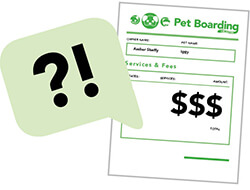
Pricing for Special Care and Services
By Laura Laaman
More often than not, pet care facility owners chose to get into this business because they were thrilled with the idea of making a living taking care of pets. They imagine a setting where lots of happy dogs are romping around and playing. That image also implies healthy dogs, which is not always the case. In any large group of dogs or cats, there will undoubtedly be a noticeable percentage of those who require some level of extra care. For example, facility owners may be asked to care for:
- Dogs that are immobile
- Puppies
- Extra-large dogs that require two people to lift when necessary
- Dogs that require a special level of trained personnel to handle them
- A pet that cannot express its bladder without assistance
- Special diets
- Diabetic dogs
The logic and the math should be simple. The more labor and skills required or increased risk of injury to you or your staff, the more you should charge. By doing so, this allows you to afford the quality staff and the extra time that is needed to properly care for these pets.
The problem with this formula is that most pet care facility owners tend to have a nurturing character that outweighs the business-savvy persona. Consequently, they are uncomfortable charging for these extra services. They believe that it’s their job to provide whatever level of care is needed, and for the same fee as a healthy, low-maintenance pet. That’s not how it works for other sustainable, successful businesses.
Here are a few examples where you have likely been the customer:
You take your car in for what you think will be a typical oil change. The mechanic discovers you need a new tail light and fan belt. Would you expect that extra work to be done for the same amount of money as just the oil change? Of course not.
When you get your hair cut by a master stylist who has more training or skill than the local barber, it’s normal that you pay more for that service, even though the amount of time spent with you is the same.
So in our business, if a pet in your care requires a special level of training and if you’re able and willing to provide these extra services, you certainly should charge more. Many facilities that charge a flat fee likely limit the level of care they deliver.
To Charge or Not to Charge?
Years ago, I was speaking on this topic to a group of pet care facility owners. One pet care facility owner asked if I felt that she should charge more for insulin injections. My first question was if she had someone (and ideally multiple people) on staff who could provide this life-saving service. It turns out, the facility owner was the only one who was adequately trained to administer the injection.
“So let’s go through the logic”, I said. “Because insulin injections need to be refrigerated and given precisely based on the veterinarian’s recommended schedule, and you have gone through special training to be able to administer the injection, doesn’t it make sense you should charge for it?”
The real issue she was having is how she could explain to the pet parent that she needed to charge extra for this very valuable service.

Most pet parents are willing to pay for the appropriate care for their pet, but aren’t willing to volunteer to pay more. Therefore, it’s the pet care facility’s responsibility to explain these additional fees and educate the customer on extra charges.
What to Say?
Consider this approach: “We love (Cocoa) and look forward to caring for her again. As you know, her care needs have changed a bit (recently). We feel comfortable that we are able to care for her current care needs, but do need to start charging a bit more for the (extra care she requires).” Then you’d explain what is needed and the amount.
How do you Determine What to Charge?
In the case above, check with a local veterinarian to see what they charge for the service. You would likely charge less than that each time you administer that service, since you don’t have the same level of training or the amount of trained staff.
If you are offering additional services such as extra walks for elimination or mobility sessions, you would charge cost plus a mark-up percentage. If you only charged the actual cost, you will likely overlook a few items and therefore lose money on that pet’s stay.
Providing amazing care will give your pet parents the desired peace of mind. Charging appropriately for the level of care you provide will give your business the revenue you deserve.
Laura Laaman is president of Outstanding Pet Care. OPC helps some of the most successful pet care facilities thrive in highly competitive markets and GUARANTEES THEIR CLIENT’S SUCCESS! If you would like to receive a complementary phone evaluation, contact the OPC team at www.OutstandingPetCare.com or call 1-888-735-5667.


